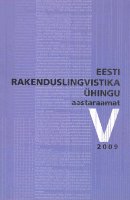Constraints of measuring language proficiency in Estonia: The national examination in the English language
Constraints of measuring language proficiency in Estonia: The national examination in the English language
Author(s): Suliko Liiv, Ene AlasSubject(s): Language and Literature Studies
Published by: Eesti Rakenduslingvistika Ühing (ERÜ)
Keywords: test validity; test reliability; test specifications; rater reliability; washback effect
Summary/Abstract: The current article gives an overview of the development and problems related to the advancement of the national examination in English in Estonia over a ten-year period, starting from its launch in 1997. The process started in 1994, after Estonia regained its independence, and proceeded from the need to standardise both foreign language instruction and evaluation. The national examination gave the Ministry of Education, schools, teachers and students an opportunity to adequately assess language proficiency, as well as compare students and schools. On the other hand, universities and businesses obtained a tool to make admission/recruitment decisions. The article discusses the principles of the national examination construction, its specifcation, structural alterations over time, the task types implemented to measure particular language skills, marking procedures, exam results and exam evaluation.
Journal: Eesti Rakenduslingvistika Ühingu aastaraamat
- Issue Year: 2009
- Issue No: 5
- Page Range: 019-032
- Page Count: 14
- Language: English

